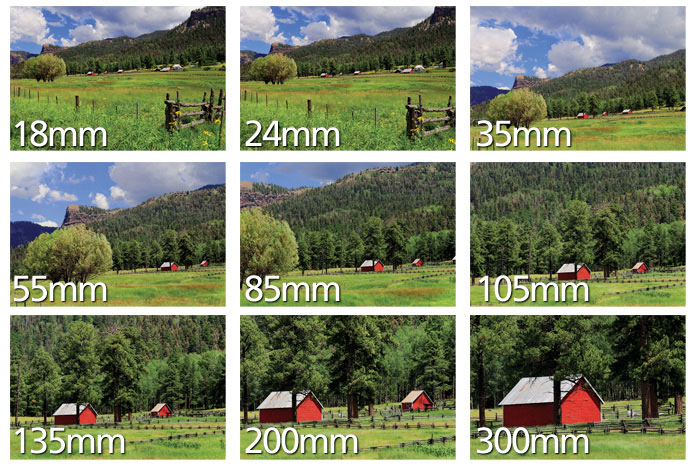How Do Camera Lenses Focus


Beginner
Understanding Focal Length

Focal length, ordinarily represented in millimeters (mm), is the basic description of a photographic lens.
What is Lens Focal Length
Focal length, usually represented in millimeters (mm), is the bones description of a photographic lens. Information technology is not a measurement of the actual length of a lens, simply a calculation of an optical distance from the signal where light rays converge to grade a sharp prototype of an object to the digital sensor or 35mm flick at the focal airplane in the camera. The focal length of a lens is determined when the lens is focused at infinity.
Lens focal length tells us the angle of view—how much of the scene will be captured—and the magnification—how large individual elements will be. The longer the focal length, the narrower the angle of view and the higher the magnification. The shorter the focal length, the wider the angle of view and the lower the magnification.
Zoom vs. Prime Lens
There are two types of lenses-prime and zoom. Prime lenses have a fixed focal length and zoom lenses have variable focal lengths.
Zoom Lens Benefits
The advantage of a zoom lens is versatility. They are platonic when you are photographing a variety of subjects such as landscapes and portraits, and you just want one lens for both situations. Using a zoom lens also reduces the number of times you need to change the lens which saves time and limits the possibility of getting dust in the camera'southward mirror box or on the sensor.
Prime Lens Benefits
The main advantages of prime lenses or fixed focal length lenses are their size and weight as well as their maximum aperture or f/end. Prime lenses tend to exist more compact and lightweight than zoom lenses.
Prime lenses also tend to have a larger maximum discontinuity (f/1.4 to f/2.8). This is an reward when shooting in low light conditions as it will increment the possibility of hand holding the camera and freezing the subject without shake or mistiness caused by the longer exposures. Photographing using prime lenses with big apertures also ways you lot can get a shallow depth of field which is useful for portraiture where you might want a softer or blurred background (also known as bokeh).
Lens Focal Length Comparison
Wide-bending Lens
FX format approx. xiv – 35mm / DX format approx. 10 – 24mm
Broad angle lenses are popular lenses for mural photography, interiors, large group photos and when working in confined situations.
© Diane Berkenfeld & Lindsay Silverman
Standard Lens
FX format approx. 50 – 60mm / DX format approx. 35mm
Standard lenses are popular as they are closest to the angle of view nosotros humans see. These lenses have minimal baloney, which can be flattering to the subject. They tend to utilize large apertures and let a lot of light to enter the lens which makes them fast in low low-cal conditions. Large apertures (f/1.8 – f/1.4) also produce a pleasing out-of-focus upshot to the background which concentrates the attention of the viewer on the bailiwick. Standard lenses are the pop choice for a wide range of photography including portraiture, nature and low calorie-free situations where the photographer tin non use a flash or is looking to capture the scene with available calorie-free.
Telephoto Lens
FX format approx. seventy – 200mm / DX format approx. 55 – 200mm
Telephoto lenses between 70 – 200mm are very pop lenses for portraiture and production photography every bit well as nature and wildlife imagery. They allow the photographer to produce close crops on the field of study. In the case of portraiture a telephoto allows the photographer to have the photograph at a distance that does non intrude upon the subject.
© Mike Corrado & Diane Berkenfeld
Super Telephoto Lens
FX format approx. 300 – 600mm / DX format approx. 200 – 600mm
These lenses provide a proficient range for wild fauna and sports photography where the photographer is limited as to how close they can get to the subject.
© Mike Corrado & Lindsay Silverman
Macro Lens
FX format 60mm, 105mm, and 200mm / DX format 85mm
Close-up photography uses a specific range of lenses that let up to one:1 reproduction. These lenses permit the photographer to focus very close to the subject and reproduce them at a 1:1 life-size ratio on film or an imaging sensor. These lenses are popular for subjects such as flowers, insects and small products.
Understanding Focal Length of DSLR Lenses – Watch the video to learn about the focal length of Nikon DSLR cameras.
Field of view of DX format NIKKOR lenses.
Field of view of DX format NIKKOR lenses.
Field of view of FX format NIKKOR lenses.
Field of view of FX format NIKKOR lenses.
This Article Goes Groovy With These Products
Source: https://www.nikonusa.com/en/learn-and-explore/a/tips-and-techniques/understanding-focal-length.html
Posted by: mcdonaldyone1997.blogspot.com

0 Response to "How Do Camera Lenses Focus"
Post a Comment